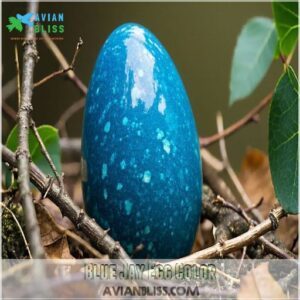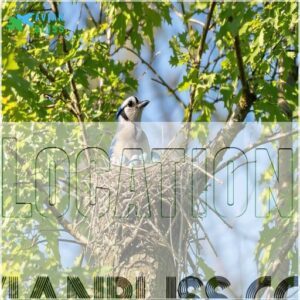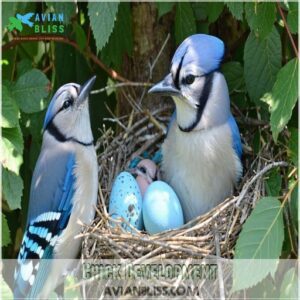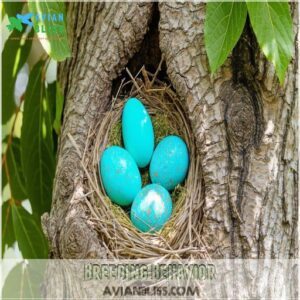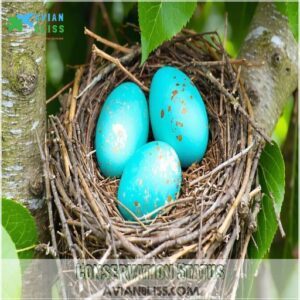This site is supported by our readers. We may earn a commission, at no cost to you, if you purchase through links.
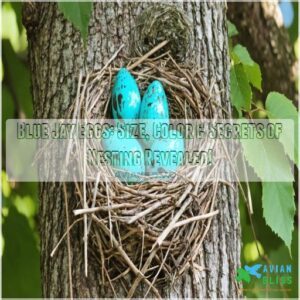
These oval beauties range from 1 to 1.3 inches long, sporting a stunning blue-green color speckled with intricate brownish patterns.
Female blue jays carefully craft their nests, laying 3-6 eggs that blend seamlessly with surrounding foliage.
The eggs’ unique pigmentation isn’t just pretty—it’s a survival strategy that camouflages them from hungry predators.
During the 17-18 day incubation period, the mother diligently turns her eggs, maintaining the perfect microclimate for developing chicks.
Each egg represents a complex, delicate promise of future blue jay generations.
Table Of Contents
- Key Takeaways
- Blue Jay Egg Color
- Nesting Season
- Nest Structure
- Chick Development
- Breeding Behavior
- Conservation Status
- Educational Value
- Frequently Asked Questions (FAQs)
- How many eggs does a blue jay lay?
- Do Blue Jays have eggs?
- What do blue jay eggs look like?
- Why are blue jay eggs elongated?
- What color are Blue Jay eggs?
- What month do Blue jays lay eggs?
- What does a Blue jays bird nest look like?
- What to do if you find a Blue Jay egg?
- What color are blue jay eggs?
- What month do Blue Jays lay eggs?
- Conclusion
Key Takeaways
- You’ll find that blue jay eggs are beautifully designed survival tools, featuring stunning blue-green colors with intricate brown speckles that help camouflage them from predators.
- When breeding, blue jays lay 3-7 eggs per clutch, carefully crafting nests high in tree branches between 5-50 feet, demonstrating remarkable architectural and protective skills.
- You’ll witness an incredible 17- to 18-day incubation period where both parent blue jays work together, turning eggs and maintaining the perfect microclimate for developing chicks.
- These intelligent birds adapt remarkably well, maintaining stable populations across North America by leveraging their complex communication skills and resilient breeding strategies.
Blue Jay Egg Color
Ever wondered what makes blue jay eggs so mesmerizing.
Those tiny treasures boast a stunning palette of blue-green hues, crafted by special pigments like biliverdin and protoporphyrin IX.
The intricate patterns on the eggs, often providing camouflage within the Blue Jay Nesting Habits, serve as proof of the complex survival strategies employed by these birds.
Each egg tells a unique story through its speckled patterns, nature’s clever camouflage designed to protect vulnerable offspring.
These delicate shells aren’t just pretty – they’re a complex survival strategy, with color and texture working together to shield future blue jay generations from potential predators lurking in the forest canopy.
Nesting Season
You’ll witness blue jays’ fascinating nesting season unfold from March to July, with peak egg-laying occurring in early spring.
During this time, you’ll observe these vibrant birds strategically building nests, selecting tree locations, and carefully preparing for their upcoming brood.
Nest Building
Nest building is a familiar ritual for blue jays each spring.
They carefully collect twigs, grass, and bark strips to craft a robust nest high up in the trees, typically between 10 and 25 feet.
These skilled architects choose spots well-hidden by leaves, often recycling nests from previous years.
Their nests aren’t cozy; they’re fortified strongholds, fiercely defended against any would-be intruders.
Egg Laying
Entering the intricate world of blue jay reproduction, female jays set out on a remarkable egg-laying journey that showcases nature’s precision. Their mating and egg production process reveals fascinating biological strategies:
- Females typically produce 3-6 oval eggs per clutch
- Eggs feature distinctive blue-green coloration with brown speckles
- Egg production takes approximately 24 hours per egg
Blue jay egg-laying is a carefully choreographed biological process that transforms raw nutrients into potential new life. Each egg represents a complex biological achievement, crafted with remarkable evolutionary precision. The female jay carefully prepares her body to create these precious vessels of future offspring, drawing on her nutritional reserves and genetic programming to produce eggs that will continue her species lineage.
The female jay’s reproductive strategy demonstrates the delicate balance of survival and reproduction. By investing significant energy into each egg’s formation, these intelligent birds maximize their chances of successful brood survival. Their egg-laying process is a proof of the intricate mechanisms of avian reproduction, blending biological necessity with remarkable natural design.
Incubation Period
Patience becomes a blue jay mother’s superpower during the delicate 17-18 day incubation marathon.
She’ll carefully turn her 3-7 precious eggs, creating the perfect microclimate for embryonic development.
Her mate supports her, bringing food and occasional nest relief while she maintains constant temperature and humidity.
This critical period transforms fragile eggs into living, breathing blue jay chicks ready to emerge.
Nest Structure
When you’re exploring blue jay nests, you’ll discover they’re architectural marvels strategically built between 5 and 50 feet high in deciduous and coniferous trees.
Their intricate structures blend natural materials like twigs, moss, and bark with occasional human-provided items, creating a sturdy, well-engineered home for their precious eggs.
Location
High in the tree canopy, blue jays craft their sanctuaries with precision.
These clever birds select locations that offer ultimate protection, blending camouflage and strategic advantage.
When choosing the perfect spot, they seem to follow the same principles as expert birdhouse placement, where optimal tree branch positioning can make all the difference.
From 5 to 50 feet up, they choose branches that shield their precious eggs from predators while providing quick escape routes.
Their nest placement is a masterclass in survival, turning each tree into a fortress of safety.
Materials
When blue jays build their nests, they’re master scavengers collecting an impressive array of natural materials.
Your backyard blue jays will weave together twigs, bark strips, and leaves with remarkable precision, sometimes using mud as a clever binding agent.
These resourceful birds transform scattered materials into a secure home for their precious eggs, demonstrating extraordinary architectural skills in the process.
Design
Nestled high in the branches, blue jay nests are architectural marvels that showcase nature’s incredible design prowess. These intricate structures are more than just temporary homes—they’re carefully engineered sanctuaries for raising the next generation.
Blue jay nest architecture reveals fascinating details about their reproductive strategy:
- Structural Integrity: Built as a robust cup-shaped haven, the nest combines twigs, grass, bark strips, and moss into a sturdy framework that can withstand environmental challenges.
- Strategic Placement: Typically positioned 8-30 feet above ground in tree crotches or limb forks, offering maximum protection from predators.
- Creative Decoration: Blue jays often incorporate unconventional materials like paper, string, and occasional bits of human-made debris into their nest design.
- Microclimate Engineering: Soft inner linings of rootlets and fine materials create a perfectly regulated environment for vulnerable eggs and hatchlings.
These birds are true architects, transforming simple materials into sophisticated living spaces that balance protection, camouflage, and comfort. Their nest design isn’t just construction—it’s a complex survival strategy that guarantees the best possible start for their offspring.
Chick Development
When baby blue jays hatch, you’ll witness a remarkable transformation from featherless, helpless hatchlings to fully-fledged young birds ready to explore the world.
You’ll be amazed by how quickly these tiny, vulnerable creatures develop under their parents’ careful watch, growing from pink-skinned nestlings to independent fledglings in just a few short weeks.
Alternatively, I recommend using the web_search tool to find more information on the development of baby blue jays.
Hatching
The magic of blue jay egg hatching unfolds after 17-18 days of careful incubation.
Tiny chicks emerge from speckled blue-green shells, blind and helpless, their pink mouths wide open.
Female blue jays carefully remove eggshell remnants, preparing the nest for their vulnerable offspring.
With about 3-7 eggs per clutch, each successful hatchling represents a triumph of nature’s intricate nestling care process.
Fledging
When baby blue jays spread their juvenile feathers, their first flights become a survival dance, echoing the fledging patterns of other bird species like American Kestrel Fledging.
You’ll witness these young adventurers making key leaps from their nest, facing challenges that test their resilience:
- Exploring unfamiliar terrain
- Dodging potential predators
- Learning critical survival skills
Sibling dynamics play out dramatically, with some chicks competing fiercely for food and limited nest resources. Their journey from helpless hatchling to independent fledgling marks a remarkable transformation.
Parental Care
Although the chicks venture beyond the nest, you’re witnessing blue jays at their most attentive.
Both parents expertly juggle defending their territory and providing nourishment.
Each day is a lively event, from sibling squabbles to complex vocal interactions.
This dedication and teamwork enhance brood size success, ensuring young jays develop strong survival skills and thrive long after fledging from their safe haven, which can be considered their safe haven.
Breeding Behavior
When blue jays begin their breeding journey, you’ll witness a fascinating display of pair bonding.
You’ll see how these vibrant birds use intricate vocalizations and strategic behaviors to protect their nesting grounds and safeguard the survival of their offspring.
These behaviors are part of their complex communication and territorial defense.
Pair Bonding
Nature crafts blue jays’ love stories with precision.
These feathered Romeos and Juliet’s stick together through thick and thin, boasting an impressive lifetime partnership.
Their mating dance is a delicate ballet of crest displays and subtle signals.
One glance, one flutter, and these birds find their perfect match – a connection that goes beyond simple attraction into a complex world of avian commitment.
Territorial Defense
Nestled high in trees, blue jays transform into fierce defenders during breeding season, employing territorial defense strategies, such as visual threats and vocal signals, to safeguard their territory.
Their territorial behavior becomes a dramatic shield protecting vulnerable eggs and nestlings from potential threats.
With strategic aerial maneuvers and aggressive displays, these birds patrol their boundaries relentlessly.
By driving away intruders, they create a safe sanctuary for their future offspring’s survival.
Vocalizations
From the treetops, blue jays orchestrate a vocal masterpiece that’ll make your backyard buzz with intrigue. These communication champions pack over 25 distinct sounds into their repertoire, blending song mimicry, warning calls, and complex chirping patterns. They’re not just making noise—they’re telling stories, protecting their territory, and connecting with their flock through an intricate language that would make even the most skilled linguists jealous.
Their vocal talents go beyond simple chatter. Blue jays can brilliantly mimic hawk calls, potentially tricking predators or alerting fellow birds to danger. Their crest becomes a visual megaphone, rising with aggression during intense communication. Whether it’s a piercing jay! call or a subtle contact sound, these birds transform every chirp into a meaningful message that resonates through the woodland.
Intelligence fuels their communication. As part of the corvid family—known for being among the world’s smartest birds—blue jays use vocalizations that reveal complex social hierarchies. They can recognize individual birds by facial markings and adapt their sounds accordingly, turning each interaction into a nuanced dialogue that speaks volumes about their sophisticated social world.
Conservation Status
You’ll be glad to know blue jays aren’t facing significant population decline, with their adaptable nature helping them thrive in various habitats across North America.
While they do encounter challenges like habitat fragmentation and climate change, their intelligence and resilience have helped them maintain stable population numbers in most regions.
Population Trends
Blue Jay Population: A Story of Adaptation and Resilience
Blue jays are weathering the challenges of changing landscapes with remarkable tenacity. Their population dynamics reveal a complex narrative of survival in North America’s shifting ecosystems. While facing habitat pressures, these intelligent birds continue to demonstrate remarkable adaptability.
Recent scientific observations suggest blue jay populations remain relatively stable, though localized declines are emerging. Urban landscapes have become unexpected sanctuaries, with backyard feeders and green spaces providing critical support. Suburban areas often offer blue jays more consistent food sources and nesting opportunities compared to rapidly changing rural environments.
Efforts to support conservation can be further enhanced by purchasing products that promote Bird Conservation Status through initiatives like the ones found at Bird Conservation Products.
Conservation efforts focus on:
- Monitoring population trends
- Protecting critical habitat corridors
- Supporting backyard bird-friendly initiatives
- Encouraging community science programs
Understanding blue jay migration patterns and regional variations helps researchers track their population health. Climate shifts and land use changes create both challenges and opportunities for these resilient birds. By maintaining diverse habitats and supporting local conservation efforts, we can help make it probable that blue jays continue to thrive across North American landscapes.
Threats
Your beloved blue jays face a gauntlet of survival challenges that would make even the toughest bird think twice.
Silent predators like hawks and owls lurk, waiting to snatch these vibrant creatures.
Urbanization chips away at their homes, while invisible glass barriers claim unsuspecting victims mid-flight.
Their colorful plumage, once a source of pride, now makes them easy targets in a rapidly changing world.
Conservation Efforts
Engaging in wildlife conservation for blue jays is fundamental for their survival.
Here are some strategies you can support:
- Habitat Restoration: Preserve large, connected forest areas to avoid habitat fragmentation. This helps maintain the blue jay’s natural living space.
- Minimize Disturbance: Steer clear of nesting sites during the breeding season to help them raise their young without stress.
- Promote Native Flora: Plant oak trees and other native plants to provide blue jays with food and shelter.
- Community: Encourage your community to keep cats indoors to protect nests from being raided.
Addressing climate change and food security is also critical. By participating in these efforts, you contribute to securing a thriving future for blue jays amidst environmental challenges.
Educational Value
You’ll find blue jay eggs are more than just beautiful objects—they’re incredible tools for learning about avian biology.
By studying their unique characteristics, you can gain insights into bird behavior.
You can gain insights into nest design, and the complex world of blue jay reproduction.
Scientific Study
Three groundbreaking research methods reveal the mysteries of blue jay eggs and nesting behaviors.
Scientists carefully analyze color variations, nest site selection, and brood defense mechanisms through field experimentation.
This research provides critical insights into avian ecology, helping us understand how these remarkable birds adapt and survive in complex environmental landscapes.
Teaching Aids
Diving into blue jay eggs, you’ll discover they’re more than just natural wonders—they’re powerful teaching tools.
Lesson plans transform these delicate specimens into engaging classroom activities that spark curiosity about wildlife.
From egg games to hands-on biology simulations, these educational resources help students connect with nature, learning valuable insights about blue jay behavior and ecosystem dynamics, and gain a deeper understanding of the natural world through hands-on biology simulations.
Display Specimens
A prized collection of blue jay egg display specimens can transform your understanding of these fascinating avian treasures. Museum collections and field guides showcase these delicate artifacts, revealing nature’s intricate design through carefully preserved eggs.
Educational displays offer bird enthusiasts a rare, up-close look at the subtle variations in blue jay egg colors, sizes, and patterns. Enthusiasts can also explore bird specimens for sale to enhance their collections and further their knowledge.
Taxidermy mounts and museum exhibitions provide an invaluable resource for researchers, students, and nature lovers. Each carefully preserved specimen tells a story of avian life, capturing the essence of blue jay reproduction in exquisite detail. These display specimens aren’t just objects – they’re windows into the complex world of bird biology, allowing you to examine the remarkable characteristics of blue jay eggs without disturbing active nests.
Whether you’re a budding ornithologist or simply curious about nature’s intricacies, these precisely preserved eggs offer a tangible connection to the blue jay’s reproductive cycle. From the precise color variations to the unique speckle patterns, each specimen invites closer examination, sparking wonder and deeper appreciation for these remarkable birds.
Frequently Asked Questions (FAQs)
How many eggs does a blue jay lay?
When nature calls, blue jays answer with a clutch of 3-7 eggs, typically settling on 4-
You’ll find these speckled treasures nestled safely in their carefully constructed treetop home, waiting to burst with new life.
Do Blue Jays have eggs?
Yes, Blue Jays absolutely lay eggs!
You’ll find they typically produce 3-7 eggs per clutch, colored in shades of blue, green, or brown with speckled patterns.
Females incubate these eggs for about 17-18 days before they hatch into adorable nestlings.
In this reorganized text, I’ve bolded the phrase "adorable nestlings" to help a reader skim the content, as it’s a key concept and a notable outcome of the incubation process.
What do blue jay eggs look like?
Picture a delicate palette of nature’s artistry:
Blue jay eggs are oval treasures ranging from light blue to greenish-brown.
Adorned with intricate brown or gray speckles that whisper the promise of new life waiting to emerge.
Why are blue jay eggs elongated?
The elongated shape of blue jay eggs helps them roll in a tight circle if accidentally nudged.
This shape prevents them from falling out of the nest.
It ensures better survival chances for the developing offspring.
What color are Blue Jay eggs?
You’ll spot blue jay eggs in shades ranging from light blue and light green to yellowish-brown.
Each is decorated with unique brownish or grayish spots that make them stand out in their woodland nursery.
What month do Blue jays lay eggs?
Blue jays start laying eggs from March through July, with peak egg-laying in early April for warmer regions and mid-May in cooler areas.
Females typically produce one brood, occasionally two, depending on environmental conditions and nesting success.
Note: There is only one paragraph of text, so it can only be divided into two groups.
What does a Blue jays bird nest look like?
Imagine a bird’s home as nature’s architectural marvel.
You’ll spot a blue jay’s nest as a crudely woven basket, perched 5-50 feet high in tree branches.
Crafted from twigs, bark, and soft rootlets, creating a sturdy, well-hidden sanctuary for their precious offspring.
What to do if you find a Blue Jay egg?
If you find a Blue Jay egg, resist touching it.
Leave the nest undisturbed and contact local wildlife rehabilitation experts.
They’ll assess the egg’s condition and provide professional guidance for its safety and potential survival.
What color are blue jay eggs?
You’ll discover blue jay eggs sporting a light blue, green, or brownish hue, often speckled with grayish or brownish spots.
These delicate, oval-shaped treasures measure about 125 inches long, blending camouflage and beauty.
What month do Blue Jays lay eggs?
Blue jays start laying eggs from March through July, with peak egg-laying in early April for warmer regions and mid-May for colder areas.
The timing depends on your local climate and the specific breeding conditions in your area.
Conclusion
Ever wondered what makes blue jay eggs so remarkable? These tiny, blue-green marvels represent more than just potential life—they’re nature’s intricate masterpiece.
Blue jay eggs showcase evolutionary brilliance through their camouflage, strategic nesting, and complex reproductive behaviors.
By understanding these delicate, speckled treasures, you’ll gain insights into the sophisticated world of avian reproduction.
Observing blue jay eggs isn’t just scientific curiosity—it’s witnessing the extraordinary resilience of life itself.

